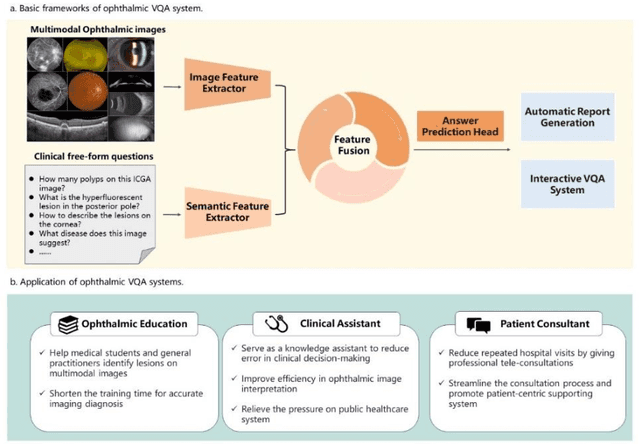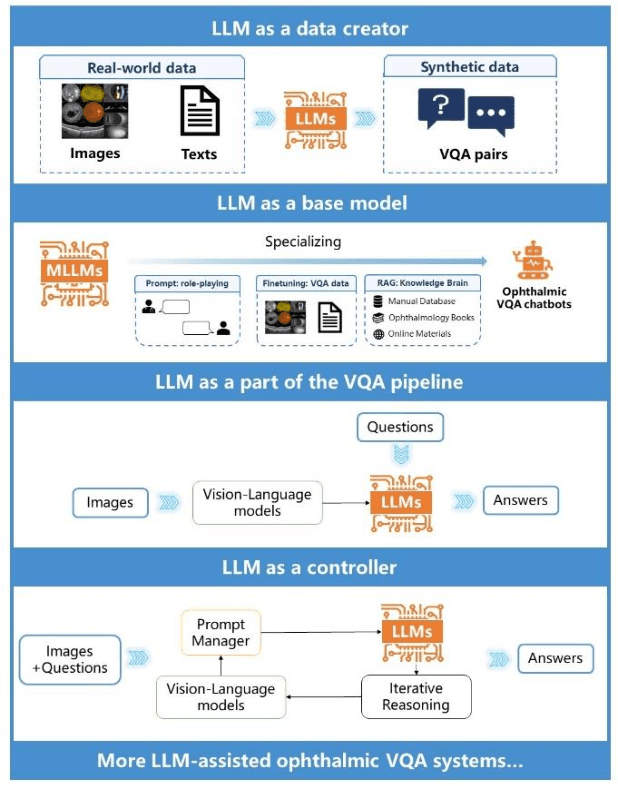Xiaolan Chen
DeepSeek-R1 Outperforms Gemini 2.0 Pro, OpenAI o1, and o3-mini in Bilingual Complex Ophthalmology Reasoning
Feb 25, 2025Abstract:Purpose: To evaluate the accuracy and reasoning ability of DeepSeek-R1 and three other recently released large language models (LLMs) in bilingual complex ophthalmology cases. Methods: A total of 130 multiple-choice questions (MCQs) related to diagnosis (n = 39) and management (n = 91) were collected from the Chinese ophthalmology senior professional title examination and categorized into six topics. These MCQs were translated into English using DeepSeek-R1. The responses of DeepSeek-R1, Gemini 2.0 Pro, OpenAI o1 and o3-mini were generated under default configurations between February 15 and February 20, 2025. Accuracy was calculated as the proportion of correctly answered questions, with omissions and extra answers considered incorrect. Reasoning ability was evaluated through analyzing reasoning logic and the causes of reasoning error. Results: DeepSeek-R1 demonstrated the highest overall accuracy, achieving 0.862 in Chinese MCQs and 0.808 in English MCQs. Gemini 2.0 Pro, OpenAI o1, and OpenAI o3-mini attained accuracies of 0.715, 0.685, and 0.692 in Chinese MCQs (all P<0.001 compared with DeepSeek-R1), and 0.746 (P=0.115), 0.723 (P=0.027), and 0.577 (P<0.001) in English MCQs, respectively. DeepSeek-R1 achieved the highest accuracy across five topics in both Chinese and English MCQs. It also excelled in management questions conducted in Chinese (all P<0.05). Reasoning ability analysis showed that the four LLMs shared similar reasoning logic. Ignoring key positive history, ignoring key positive signs, misinterpretation medical data, and too aggressive were the most common causes of reasoning errors. Conclusion: DeepSeek-R1 demonstrated superior performance in bilingual complex ophthalmology reasoning tasks than three other state-of-the-art LLMs. While its clinical applicability remains challenging, it shows promise for supporting diagnosis and clinical decision-making.
EyeDiff: text-to-image diffusion model improves rare eye disease diagnosis
Nov 15, 2024Abstract:The rising prevalence of vision-threatening retinal diseases poses a significant burden on the global healthcare systems. Deep learning (DL) offers a promising solution for automatic disease screening but demands substantial data. Collecting and labeling large volumes of ophthalmic images across various modalities encounters several real-world challenges, especially for rare diseases. Here, we introduce EyeDiff, a text-to-image model designed to generate multimodal ophthalmic images from natural language prompts and evaluate its applicability in diagnosing common and rare diseases. EyeDiff is trained on eight large-scale datasets using the advanced latent diffusion model, covering 14 ophthalmic image modalities and over 80 ocular diseases, and is adapted to ten multi-country external datasets. The generated images accurately capture essential lesional characteristics, achieving high alignment with text prompts as evaluated by objective metrics and human experts. Furthermore, integrating generated images significantly enhances the accuracy of detecting minority classes and rare eye diseases, surpassing traditional oversampling methods in addressing data imbalance. EyeDiff effectively tackles the issue of data imbalance and insufficiency typically encountered in rare diseases and addresses the challenges of collecting large-scale annotated images, offering a transformative solution to enhance the development of expert-level diseases diagnosis models in ophthalmic field.
Visual Question Answering in Ophthalmology: A Progressive and Practical Perspective
Oct 22, 2024

Abstract:Accurate diagnosis of ophthalmic diseases relies heavily on the interpretation of multimodal ophthalmic images, a process often time-consuming and expertise-dependent. Visual Question Answering (VQA) presents a potential interdisciplinary solution by merging computer vision and natural language processing to comprehend and respond to queries about medical images. This review article explores the recent advancements and future prospects of VQA in ophthalmology from both theoretical and practical perspectives, aiming to provide eye care professionals with a deeper understanding and tools for leveraging the underlying models. Additionally, we discuss the promising trend of large language models (LLM) in enhancing various components of the VQA framework to adapt to multimodal ophthalmic tasks. Despite the promising outlook, ophthalmic VQA still faces several challenges, including the scarcity of annotated multimodal image datasets, the necessity of comprehensive and unified evaluation methods, and the obstacles to achieving effective real-world applications. This article highlights these challenges and clarifies future directions for advancing ophthalmic VQA with LLMs. The development of LLM-based ophthalmic VQA systems calls for collaborative efforts between medical professionals and AI experts to overcome existing obstacles and advance the diagnosis and care of eye diseases.
Fundus to Fluorescein Angiography Video Generation as a Retinal Generative Foundation Model
Oct 17, 2024Abstract:Fundus fluorescein angiography (FFA) is crucial for diagnosing and monitoring retinal vascular issues but is limited by its invasive nature and restricted accessibility compared to color fundus (CF) imaging. Existing methods that convert CF images to FFA are confined to static image generation, missing the dynamic lesional changes. We introduce Fundus2Video, an autoregressive generative adversarial network (GAN) model that generates dynamic FFA videos from single CF images. Fundus2Video excels in video generation, achieving an FVD of 1497.12 and a PSNR of 11.77. Clinical experts have validated the fidelity of the generated videos. Additionally, the model's generator demonstrates remarkable downstream transferability across ten external public datasets, including blood vessel segmentation, retinal disease diagnosis, systemic disease prediction, and multimodal retrieval, showcasing impressive zero-shot and few-shot capabilities. These findings position Fundus2Video as a powerful, non-invasive alternative to FFA exams and a versatile retinal generative foundation model that captures both static and temporal retinal features, enabling the representation of complex inter-modality relationships.
EyeCLIP: A visual-language foundation model for multi-modal ophthalmic image analysis
Sep 10, 2024Abstract:Early detection of eye diseases like glaucoma, macular degeneration, and diabetic retinopathy is crucial for preventing vision loss. While artificial intelligence (AI) foundation models hold significant promise for addressing these challenges, existing ophthalmic foundation models primarily focus on a single modality, whereas diagnosing eye diseases requires multiple modalities. A critical yet often overlooked aspect is harnessing the multi-view information across various modalities for the same patient. Additionally, due to the long-tail nature of ophthalmic diseases, standard fully supervised or unsupervised learning approaches often struggle. Therefore, it is essential to integrate clinical text to capture a broader spectrum of diseases. We propose EyeCLIP, a visual-language foundation model developed using over 2.77 million multi-modal ophthalmology images with partial text data. To fully leverage the large multi-modal unlabeled and labeled data, we introduced a pretraining strategy that combines self-supervised reconstructions, multi-modal image contrastive learning, and image-text contrastive learning to learn a shared representation of multiple modalities. Through evaluation using 14 benchmark datasets, EyeCLIP can be transferred to a wide range of downstream tasks involving ocular and systemic diseases, achieving state-of-the-art performance in disease classification, visual question answering, and cross-modal retrieval. EyeCLIP represents a significant advancement over previous methods, especially showcasing few-shot, even zero-shot capabilities in real-world long-tail scenarios.
EyeFound: A Multimodal Generalist Foundation Model for Ophthalmic Imaging
May 22, 2024Abstract:Artificial intelligence (AI) is vital in ophthalmology, tackling tasks like diagnosis, classification, and visual question answering (VQA). However, existing AI models in this domain often require extensive annotation and are task-specific, limiting their clinical utility. While recent developments have brought about foundation models for ophthalmology, they are limited by the need to train separate weights for each imaging modality, preventing a comprehensive representation of multi-modal features. This highlights the need for versatile foundation models capable of handling various tasks and modalities in ophthalmology. To address this gap, we present EyeFound, a multimodal foundation model for ophthalmic images. Unlike existing models, EyeFound learns generalizable representations from unlabeled multimodal retinal images, enabling efficient model adaptation across multiple applications. Trained on 2.78 million images from 227 hospitals across 11 ophthalmic modalities, EyeFound facilitates generalist representations and diverse multimodal downstream tasks, even for detecting challenging rare diseases. It outperforms previous work RETFound in diagnosing eye diseases, predicting systemic disease incidents, and zero-shot multimodal VQA. EyeFound provides a generalizable solution to improve model performance and lessen the annotation burden on experts, facilitating widespread clinical AI applications for retinal imaging.
Evaluating large language models in medical applications: a survey
May 13, 2024Abstract:Large language models (LLMs) have emerged as powerful tools with transformative potential across numerous domains, including healthcare and medicine. In the medical domain, LLMs hold promise for tasks ranging from clinical decision support to patient education. However, evaluating the performance of LLMs in medical contexts presents unique challenges due to the complex and critical nature of medical information. This paper provides a comprehensive overview of the landscape of medical LLM evaluation, synthesizing insights from existing studies and highlighting evaluation data sources, task scenarios, and evaluation methods. Additionally, it identifies key challenges and opportunities in medical LLM evaluation, emphasizing the need for continued research and innovation to ensure the responsible integration of LLMs into clinical practice.
EyeGPT: Ophthalmic Assistant with Large Language Models
Feb 29, 2024



Abstract:Artificial intelligence (AI) has gained significant attention in healthcare consultation due to its potential to improve clinical workflow and enhance medical communication. However, owing to the complex nature of medical information, large language models (LLM) trained with general world knowledge might not possess the capability to tackle medical-related tasks at an expert level. Here, we introduce EyeGPT, a specialized LLM designed specifically for ophthalmology, using three optimization strategies including role-playing, finetuning, and retrieval-augmented generation. In particular, we proposed a comprehensive evaluation framework that encompasses a diverse dataset, covering various subspecialties of ophthalmology, different users, and diverse inquiry intents. Moreover, we considered multiple evaluation metrics, including accuracy, understandability, trustworthiness, empathy, and the proportion of hallucinations. By assessing the performance of different EyeGPT variants, we identify the most effective one, which exhibits comparable levels of understandability, trustworthiness, and empathy to human ophthalmologists (all Ps>0.05). Overall, ur study provides valuable insights for future research, facilitating comprehensive comparisons and evaluations of different strategies for developing specialized LLMs in ophthalmology. The potential benefits include enhancing the patient experience in eye care and optimizing ophthalmologists' services.
 Add to Chrome
Add to Chrome Add to Firefox
Add to Firefox Add to Edge
Add to Edge